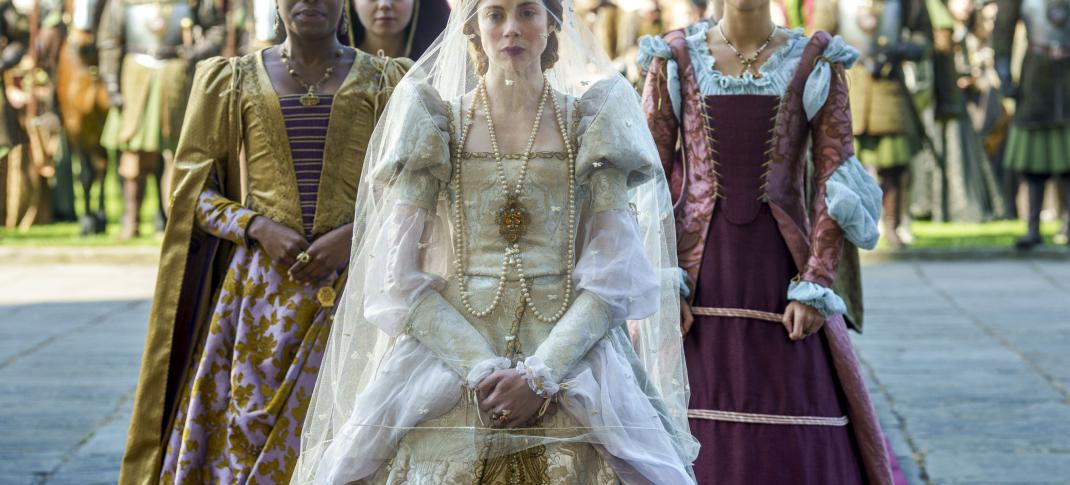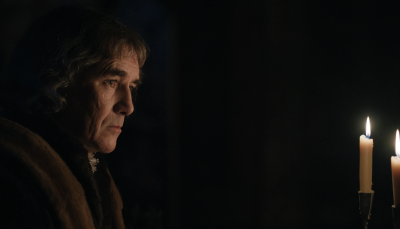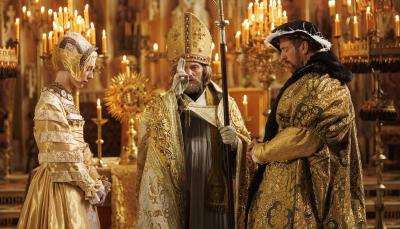Did 'The Spanish Princess' Get Catherine of Aragon Right?

Oh dear, STARZ, what happened? I am talking, of course, about the first installment of The Spanish Princess and realizing that now a second season is in the works, this might be a good time to decipher the real-life mystery of Catherine of Aragon. If you watched the series, you may have noticed the disclaimer at the end of each episode noting that historical details may have been altered, presumably by both author Philippa Gregory - who wrote the novels upon which the show is based - and the series' scriptwriters. And that’s putting it mildly. Not to mention not counting the bizarre clothes, strange hairstyles, and surprise psychopathic behavior (yes, Margaret of Beaufort, we’re talking about you, and no, you did not murder the Princes in the Tower, who apparently weren't the sons of Edward IV anyway. I’m afraid that Henry VII was quite capable of arranging his own executions, thank you.)
In short: We're going to try to break down the real story behind this occasionally (often?) fictional re-imaginging.
Let's start with this family tree of both the Spanish and English royal families in 1501.
Catherine of Aragon was born in 1485, the daughter of Ferdinand of Aragon and Isabella of Castile, whose marriage united the two main provinces of Spain. They set about making Spain great again by expelling the Jewish population and adopting the policy of reconquista, recapturing lands held by Muslims (referred to as Moors). I’m sorry to burst the series' bubble, but although Isabella was a major participant in the warfare, it was as a strategist and administrator behind the lines. Sadly, no Girls with Swords here.
Catherine was raised by parents who considered themselves equal as monarchs. The blood of English royalty ran in her veins and she was named in honor of her great-grandmother Katherine of Lancaster. Just as her parents considered themselves to be ordained by God to unite Spain, so she was raised to fulfil a destiny of her own as Queen of England, with negotiations starting between the two countries when she was an infant. Despite the submission that even royal women were supposed to display to their husbands, Catherine, like her mother, had a core of steel.
Catherine was highly educated, fluent in Latin and had studied both the classics and theological works. She was taught music, dancing, and drawing, and also basic domestic skills such as spinning, weaving and baking, skills which all aristocratic Spanish women learned. When she became Queen of England she took pride in making and embroidering her husband’s shirts and providing Henry with late night snacks. Spain and its two rulers were fiercely Catholic, but Isabella taught her daughters the modern, humanist ideal that it was possible to lead a pious life within the world, not in retreat at a religious institution. Catherine herslef was deeply religious.

At this time, the world powers were Spain, France, and the Habsburg Empire, which was centered in modern Austria. All royal marriages were planned to be of strategic advantage to both sides and royal children understood from an early age that they were pawns in the marriage game.
England was not considered one of the big three and there was a good reason for it - largely thanks to that family tree we mentioned earlier. Henry VII’s claim to the throne was a little dodgy, to put it mildly, and he had many existing family members with strong claims to the throne. If he intended to establish a dynasty, that meant arranging significant marriages for his children.
Negotiations for a betrothal began in 1496 when both Catherine and Arthur, the Prince of Wales, were aged ten, and a betrothal by proxy took place the following year, with the Spanish ambassador standing in for Catherine. Afterward, Catherine was allowed to use the title of Princess of Wales, and both sets of parents exchanged affectionate letters, barbed with the occasional reminder from the Spanish rulers that this marriage was far more advantageous for England than Spain.
The betrothal was by no means a guarantee that a wedding might take place. Both sides knew that a death or birth in one of the major royal houses of Europe before Arthur came of age at 14 would open up wonderful new marital opportunities. Ferdinand dragged his feet on sending Catherine’s 100,000 crown dowry to England, just in case it wasn't needed.
In 1499, a marriage by proxy took place in England, with the Spanish envoy Dr. de Roderigo Gonzalva de Puebla reprising his starring female role, taking the vows in Catherine’s name and the seat of honor at the king’s right hand at the wedding feast. Hilariously, the ritual also included a bedding of the happy couple, with de Puebla’s leg being inserted into the marriage bed. But Arthur still wasn’t of age and Ferdinand, fearing that his envoy would be corrupted by the English, sent a spy to make sure Arthur wasn’t married off to a better prospect.
The happy young couple corresponded in Latin, and finally, when Arthur turned 14 the following year, a second proxy marriage ceremony was performed. This was not a good year for the Spanish royal family—Ferdinand and Isabella’s eldest son and daughter both died, bringing the succession into question, and there was a Moorish uprising. Catherine was originally sent to England in August of 1500, but the ships had to turn back because of storms. Bad weather accompanied the second sailing, but a seasick Catherine made it to England on her second try. Still, you can imagine that years later people would take this as a bad omen.
Along the journey to London, crowds came out to see the Spanish princess and her retinue, and she was greeted with enthusiasm. About thirty miles west of London, the Spanish party met King Henry and Arthur, who had come to check out the goods. Since the belief of the times was that outward appearance mirrored character and fecundity, the English royals were relieved that Catherine, small, plump and pretty, with reddish hair and a fair complexion, as well as a surprisingly deep voice, was satisfactory.

We don’t know Catherine’s reaction to Arthur, but she may have thought he didn’t live up to his grandiose name. Catherine, at less than five feet tall, was a head taller than Arthur. Sadly, although both spoke fluent Latin, he could not understand her accent.
With much pageantry and over-the-top symbolism, they reached London. Yet another marriage ceremony was performed, and Catherine was escorted down the aisle by the future Henry VIII, Arthur’s younger brother. And STARZ, Ms. Gregory: Henry was ten. Yes, ten. He probably thought Catherine had cooties. He may have been taller than Arthur, but ten.
Then—another hilarious detail—at the wedding feast Catherine sat at Henry VII’s right hand at the high table and Arthur sat at the children’s table with his younger siblings.
As with other rituals of royal life, the consummation of a marriage was of great significance, and years later the veracity of this one was fiercely debated. A retinue accompanied the Prince into the bedchamber where Catherine had been put to bed by her ladies, in an extraordinary mix of ribaldry, prayer and pomp. Finally the couple were left alone.
Passionately religious, Catherine would or could not lie about the consummation of her marriage, something STARZ and Ms. Gregory conveniently ignore for the sake of drama. In this period quite often consummation was delayed, usually to protect the woman’s health if she were very young. In this case, you have to wonder whether poor little Arthur had even reached puberty, and soon after the marriage he was sent off to Ludlow Castle on the Welsh border. Decades later, trying to prove that consummation had taken place, witnesses suddenly remembered that Arthur had emerged the next morning making crude jokes about the night he’d spent “in Spain.”
Meanwhile, the issue of Catherine's dowry dragged on. Henry VII had received half upfront with the understanding that the balance would be paid as soon as it was confirmed that Catherine would be supported financially by income from her husband’s estates in Wales, Cornwall and Chester. But Ferdinand announced that part of the balance would be paid in plate and jewels, not the cash Henry VII desperately needed. Catherine, who already owned her own plate and jewels, joined her husband in Ludlow.
Early in 1502, disaster struck. Both Catherine and Arthur became ill with the sweating sickness, a mysterious and deadly malady that appeared from the late fifteenth to mid sixteenth century in England. Catherine recovered, but Arthur died, a blow to the burgeoning Tudor dynasty. As usual with an unexpected royal death, frenzied speculation arose at the possibility of new alliances. Then the following year, Queen Elizabeth died, making Henry VII, now in his mid forties, bachelor number one of Europe. Essentially Catherine (and her dowry, still not fully paid) were up for grabs. Prince Henry was, or would be, available on his fourteenth birthday to marry her, but Henry VII, so rumor had it, was also interested.
A chorus of outrage from Spain countered that Catherine and Henry VII were too closely related since consanguinity (blood relation) and affinity (relation by marriage) were considered equal. This was despite the fact that all sorts of bizarre pairings, with the Pope smoothing the way, characterized the royal families of the time. It’s important to remember that years later Henry VIII’s appeal to the Pope to end his marriage to Catherine was not an isolated incident.
The real issue for the Spanish may well have been that Catherine, had she married Henry VII, might not have become a queen. Henry VII did not crown his first wife Elizabeth until she had produced a son for him, some two years after the marriage. Prince Henry was a much better bet. Henry VII was looking at other prospects for his son but decided to hold out for the balance of the dowry, and Catherine and the Prince became betrothed in 1503.
Ferdinand arranged for a dispensation from the Pope for the marriage of Catherine and Prince Henry, but made a choice in the wording that was to wreck Katherine when almost thirty years later she was fighting to save her marriage and her position as queen. The document stated that “perhaps” her marriage to Arthur had been consummated, Ferdinand claiming that he needed to address all possibilities.
The years following Arthur’s death were not happy ones for Catherine. Living in Durham in the north of England, she still spoke hardly any English. She had fired her tutor and confessor after he allegedly spread a rumor that she was pregnant by Arthur, and her senior attendant also left around the same time. She was short of money and could not provide dowries for her attendants, let alone adequately run her household. Henry VII, still holding out for the balance of her dowry from Spain, would not support her and she was no longer eligible for funds from her late husband’s estates (now inherited by Prince Henry).
In 1504 Queen Isabella died and the united Spain fell apart. Meanwhile Henry VII signed the Treaty of Windsor which allied him, King Philip of Castile and the Habsburg Empire against Aragon, ruled by Catherine’s father Ferdinand.
Another blow came in 1505, when the day before his 14th birthday, Prince Henry formally ended his betrothal to Catherine, almost certainly at the bidding of his father. Catherine begged her father for money to maintain her household. Possibly Ferdinand’s delayed response, waiting until 1507 to send his daughter money, was inspired by the happy thought that her financial situation would force her to spend time in the English royal court and catch the attention of Prince Henry. Henry VII countered by claiming that the original jewelry and plate belonging to Catherine that she had taken to Ludlow was now his, since the terms of the dowry had not been met.
By 1509, Catherine had had enough. Encouraged by her new ambassador, she made the decision to go back to Spain, but in April Henry VII died and everything changed.
Henry VIII has gone down in history as the bloated tyrannical monster of his later years. But in his youth he was handsome, slim and athletic, loved music and dancing, and was possessed of enormous charm (The photo below depicts him at the age of eighteen. Swipe right, ladies).

In early June of 1509 he and Catherine were married and she was crowned Queen later in the month in a lavish ceremony. It was probably as close to a love match as a royal wedding could be in that period. It’s tempting to speculate how history would have changed if Henry and Catherine had had sons.
Here’s an excerpt from another fictional account of the Tudors, as seen through the eyes of Thomas Cromwell, from the bestselling novel Wolf Hall by Hilary Mantel. The third book in her trilogy, The Mirror and the Light, will be released in 2020 and I certainly hope the televised version will become available soon afterward. Here, Cardinal Wolsey remembers the young Catherine of Aragon:
“And then when she first danced at court—our poor prince Arthur sat smiling on the dais, but the little girl could hardlysit still in her chair—no one knew the Spanish dances, so she took to the floor with one of her ladies. I will never forget that turn of her head, that moment when her beautiful red hair slid over one shoulder . . . There was no man who saw it who didn’t imagine—though the dance was in fact very sedate . . . Ah dear. She was sixteen.” The cardinal looks into space and Thomas says, “God forgive you?”
Share your thoughts about fictionalized accounts, books or screen, of the Tudors. Do you have a favorite? Are you looking forward to seeing and/or reading the conclusion of Hilary Mantel’s trilogy? Or the second half of The Spanish Princess?




